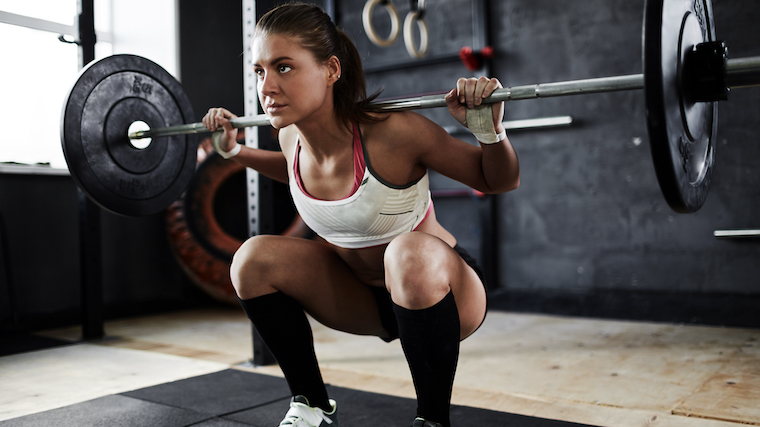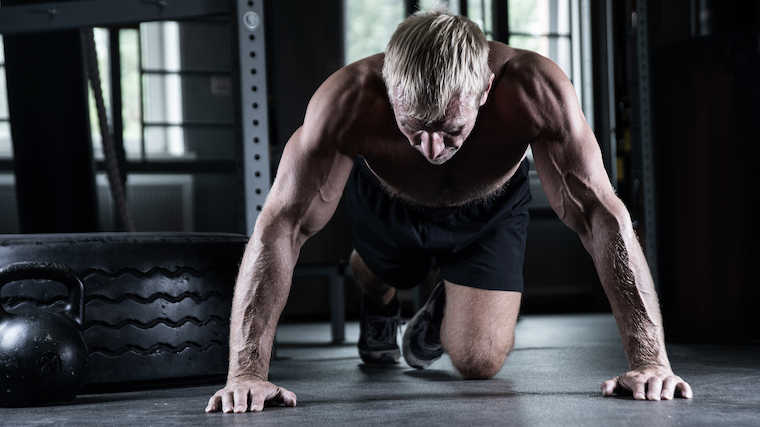If you’re focused on getting really strong, then you probably have tossed cardio to the curb. Or, if you do cardio, then it’s a short, intense HIIT (high-intensity interval training). After all, too much cardio will take pounds off of your lifts and turn you into a sinewy heap of useless, weak muscle tissue, right?
Wrong. When timed correctly, jogging is not bad for strength. Low intensity, steady-state cardio (LISS) — often described as the opposite of HIIT — can have advantages over sprint training and metabolic conditioning (also known as “metcons“). If you have strength goals, whether they be a bigger squat or a stronger deadlift, a jogging habit can help improve joint stability and not tax muscles to the point of exhaustion. LISS applies less pressure on the central nervous system (CNS) than more intense forms of cardio and can be done in or out of the gym.
Assuming your jogging form is on point, there are many benefits to be had from incorporating a moderate amount into your routine.
Jogging Benefits and What To Know
HIIT vs. LISS
Contrary to popular belief, sprints are not the end all be all for cardiovascular benefits and fat burning. It’s not that HIIT is useless for either of those purposes — in fact, HIIT is awesome. Studies have shown that high-intensity training is better for endurance and creating a hormonal environment conducive to fat loss than LISS. (1)
Fitness is more complicated than that, though. For example, one study compared 10 seconds of “sprints” on an exercise bike to 20-25 minutes of steady-state training over 15 weeks and found that the sprints were better for improving endurance and power output. Still, the steady-state training was just as effective at improving the maximum rate of oxygen consumption (VO2 max). (2) For those unfamiliar, athletes with a higher VO2 max have better endurance than athletes with a lower VO2 max. And when it comes to getting stronger, more endurance means you can apply more intensity and work longer. In short: You’re increasing your work capacity.
High-intensity intervals do have the additional benefit of increased excess post-exercise oxygen consumption (EPOC) — perhaps more colloquially known as “afterburn” — which is the effect that continues burning calories after you exercise. However, the afterburn isn’t that pronounced. A 2006 study found this post-exercise calorie burn was six to 15 percent, so if you burned 1,000 calories in a workout, you’d burn at most 150 extra calories from the EPOC. That’s slightly less than three Oreo cookies. (3)
That afterburn effect doesn’t get better as your fitness improves. It actually appears to be the opposite. A study published in the Journal of Applied Physiology found that in nine well-trained individuals, the average EPOC was just 4.8 percent, and in one case, just one percent. (4) That would just be 48 additional calories burned from that 1000-calorie workout.

[Related: Check Out The Best Treadmills For Running]
Jogging for Strength Training
If your goal is gaining strength, it usually doesn’t matter what kind of exercise increases oxygen consumption or burns more fat. The question we want to answer is, can a jogging habit improve your total?
We asked strength coach, marathon runner, and manager of CrossFit Solace in New York City, Kenny Santucci, for his take on how running impacts strength.
“Obviously, a lot of running beats the shit out of your body, but thirty to forty-five minutes in the morning can help a lot of goals,” Santucci says. ”It can really be beneficial for building overall stabilization and stability in the ankles, hips, and knees — and that constant pounding builds a little durability in your lower half and your midline.”
He notes that he tries to limit his endurance training to three days a week when training for an ironman or marathon. Otherwise, Santucci finds it counterproductive to his strength goals because of its toll on the body. On the flip side of the coin, not incorporating any cardio means an athlete could empty all the gas in their tank far too quickly.
“I know a lot of powerlifters who have to go sit on the sidelines for three or four minutes to catch their breath after one lift,” he says. “Adding some jogging two or three times a week strengthens the cardiovascular system and helps to recover a bit faster, and in that way, it helps you strength train.”
[Related: 4 Alternatives For When You Don’t Have Cardio Machines]
“Obviously, cardio alone isn’t going to help you squat or bench press more, and for as much as some lifters like to talk about work capacity, you don’t need to be able to run a 5K to make it through a powerlifting meet,” adds Ben Pollack, a BarBend contributor and former holder of the all-time world record powerlifting total in the 198-pound class.
According to Pollack, a lot of strength athletes make the mistake of neglecting cardiovascular work completely. In addition to the health benefits cardio offers, such as lower risk of cardiovascular disease and reduced inflammation, it can also help alleviate soreness, improve sleep and appetite, and warm up the body for general mobility workouts. (5)

[Related: How To Strength Train For Your 5K (And Why You Should)]
Reduced Muscle Exhaustion
Most kinds of HIIT and metcons — be they cycling, burpees, or rowing — fatigue large muscle groups. That can be great if you’re trying to burn a ton of calories, but if your goal is steady strength gains, then it’s going to be pretty hard to properly max your deadlift tomorrow if you’ve done a scorching metcon of kettlebell swings.
Joggings Affect On the Central Nervous System
HIIT eats up less time but is far more intense than jogging. That means it will more heavily tax your CNS — the system that stems from your brain and controls your movement — making for lackluster strength workouts. Simply put: jogging will afford you the same endurance and fat-burning benefits but without the hindering soreness.
“Remember, the point is recovery,” says Pollack. “Hour-long bouts and wind sprints aren’t going to help with that. Try to keep the duration of each session short, and your heart rate somewhere in the range of 60 to 70 percent of max.” Pollack himself sticks to twenty to thirty minutes of low-intensity cardio once or twice a week.
View this post on Instagram
[Related: 4 Keys to Using Running Intervals to Improve Your Metcons]
Ease Of Programming
If you’re following a specific strength-training program and it consists of just lifts, sets, and reps, then dropping HIIT or metcons throughout the week can jeopardize the progress plan. However, two or three brisk jogs a week can fit into almost any strength-only plan.
Getting Out Of The Gym
“I’ve been working out since I was 15 years old and sometimes it gets boring doing the same thing all the time,” says Santucci. “Sometimes you need to change it up and want to enjoy the outdoors. It refreshes your routine, and on days you just don’t want to go to the gym, going outside is probably more beneficial.”
“Probably” is key there as some studies have shown that psychological wellbeing is similar across all exercise environments unless an individual already has a comfortable relationship with nature. That is to say, training where you’re comfortable has shown to lower anxiety levels. So if you are looking to refresh your training and enjoy the outdoors, lower anxiety is an additional reward for doing so. (6)

[Related: Kettlebell Cardio — Save Time And Space While Breaking A Sweat]
Perfect Your Jogging Form
The finer points of running form are the kind of subject that could fill a book, but perhaps the most common mistake people make is that they kick their feet far out in front of them when they run.
“That’s where you get a lot of shin splints and hip and ankle problems,” says Santucci. “Instead, you want a very slight lean forward in the torso and a tight midline, so you’re letting your upper body pull you forward.”
The idea is to have as little ground contact time as possible, which will increase your cadence and foot turnover.
Instead of leaping forward, think about feeling “tall” and “bouncy.” When you’re trying to feel tall, you’re going to keep your hips high, which will help stop you from striking out in front of you. Keep your feet beneath your center of mass. That, in turn, will help your step be springier, keep your feet on the ground for less time, and lower your injury risk.
Nail Your Jogging Form
- Don’t kick your feet out too far in front of you.
- Lean your torso forward slightly (think of your upper body pulling you forward).
- Maintain a tight midline.
- Have as little contact time with the ground as possible.
- Use the cue of “feeling tall” or “bouncing.”
- Keep your feet beneath your center of mass.

[Related: Dynamic Warm-Up For Running – Benefits And Sample Warm-Up Routines/Exercises]
The Takeaway
When the goal is to gain strength, the benefits of adding moderate jogging to your routine are clear. It can help build a better VO2 max and help you recover more efficiently. Alternatively, HIIT can build a better anaerobic metabolism, which can help power output but comes with the drawback of heavily burdening the CNS.
20- to 40-minute sessions of jogging two or three times a week can be a great way to improve your cardiovascular capacity, blood flow, recovery between sets, and energy efficiency without crushing your CNS or interfering with your strength program.
[Related: Study: Volume & Intensity, Not Frequency, Weigh Heaviest For Maximal Strength Gains]
References
- Bryan A. Irving, et al. Effect of exercise training intensity on abdominal visceral fat and body composition. Nov. 2008. Medicine and Science in Sports and Exercise. doi: 10.1249/MSS.0b013e3181801d40.
- Kei Tanisho, Kazufumi Hirakawa. Training effects on endurance capacity in maximal intermittent exercise: comparison between continuous and interval training. Nov. 2009. Journal of Strength and Conditioning Research. doi: 10.1519/JSC.0b013e3181bac790.
- J LaForgia, et al. Effects of exercise intensity and duration on the excess post-exercise oxygen consumption. Dec. 2006. Journal of Sports Sciences. doi: 10.1080/02640410600552064.
- CJ Gore, RT Withers. Effect of exercise intensity and duration on postexercise metabolism. June 1990. Journal of Applied Physiology. doi: 10.1152/jappl.1990.68.6.2362.
- Kelsey Pinckard, et al. Effects of Exercise to Improve Cardiovascular Health. June 2019. Frontiers in Cardiovascular Medicine. doi: 10.3389/fcvm.2019.00069.
- Emma Lawton, et al. The Relationship between the Physical Activity Environment, Nature Relatedness, Anxiety, and the Psychological Well-being Benefits of Regular Exercisers. June 2017. Frontiers in Psychology. doi: 10.3389/fpsyg.2017.01058.
Featured image via @elleryphotos on Instagram.